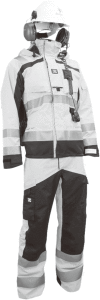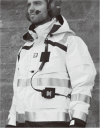A user-centred design process of new cold-protective clothing for offshore petroleum workers operating in the Barents Sea
- PMID: 29046494
- PMCID: PMC5718777
- DOI: 10.2486/indhealth.2017-0127
A user-centred design process of new cold-protective clothing for offshore petroleum workers operating in the Barents Sea
Abstract
Petroleum operations in the Barents Sea require personal protective clothing (PPC) to ensure the safety and performance of the workers. This paper describes the accomplishment of a user-centred design process of new PPC for offshore workers operating in this area. The user-centred design process was accomplished by mixed-methods. Insights into user needs and context of use were established by group interviews and on-the-job observations during a field-trip. The design was developed based on these insights, and refined by user feedback and participatory design. The new PPC was evaluated via field-tests and cold climate chamber tests. The insight into user needs and context of use provided useful input to the design process and contributed to tailored solutions. Providing users with clothing prototypes facilitated participatory design and iterations of design refinement. The group interviews following the final field test showed consensus of enhanced user satisfaction compared to PPC in current use. The final cold chamber test indicated that the new PPC provides sufficient thermal protection during the 60 min of simulated work in a wind-chill temperature of -25°C.
Conclusion: Accomplishing a user-centred design process contributed to new PPC with enhanced user satisfaction and included relevant functional solutions.
Keywords: Cold exposure; Participatory design; Petroleum workers; Protective clothing; User-centred design.
Figures



Similar articles
-
A Novel Adjustable Concept for Permeable Gas/Vapor Protective Clothing: Balancing Protection and Thermal Strain.Ann Work Expo Health. 2018 Feb 13;62(2):232-242. doi: 10.1093/annweh/wxx101. Ann Work Expo Health. 2018. PMID: 29293872
-
Effect of cold conditions on manual performance while wearing petroleum industry protective clothing.Ind Health. 2011;49(4):443-51. doi: 10.2486/indhealth.ms1236. Epub 2011 Jun 21. Ind Health. 2011. PMID: 21697624
-
Thermal comfort sustained by cold protective clothing in Arctic open-pit mining-a thermal manikin and questionnaire study.Ind Health. 2017 Dec 7;55(6):537-548. doi: 10.2486/indhealth.2017-0154. Epub 2017 Oct 11. Ind Health. 2017. PMID: 29021416 Free PMC article.
-
Design considerations for low-level risk personal protective clothing: a review.Ind Health. 2019 Jun 4;57(3):306-325. doi: 10.2486/indhealth.2018-0040. Epub 2018 Aug 8. Ind Health. 2019. PMID: 30089764 Free PMC article. Review.
-
Review of chamber design requirements for testing of personal protective clothing ensembles.J Occup Environ Hyg. 2007 Aug;4(8):562-71. doi: 10.1080/15459620701448416. J Occup Environ Hyg. 2007. PMID: 17558802 Review.
Cited by
-
New development of research on personal protective equipment (PPE) for occupational safety and health.Ind Health. 2017;55(6):471-472. doi: 10.2486/indhealth.55-471. Ind Health. 2017. PMID: 29212988 Free PMC article. No abstract available.
-
Cognitive Performance During Night Work in the Cold.Front Physiol. 2021 Dec 3;12:768517. doi: 10.3389/fphys.2021.768517. eCollection 2021. Front Physiol. 2021. PMID: 34925063 Free PMC article.
References
-
- The Goliat field. Available at: https://www.statoil.com/en/what-we-do/partner-operated-fields-in-norway/.... Accessed June 2017.
-
- Goliat on stream. Available at: http://www.eninorge.com/en/Field-development/Goliat/. Accessed June 2017.
-
- International Organization for Standardization (2010) ISO19906: Petroleum and natural gas industries—Arctic offshore structures.
-
- NORSOK (2007) N-003 Actions and actions effects. 2007.
-
- IPIECA/OGP (2008) Health aspects of work in extreme climates. A guide for oil and gas industry managers and supervisors, London.
MeSH terms
LinkOut - more resources
Full Text Sources
Other Literature Sources

